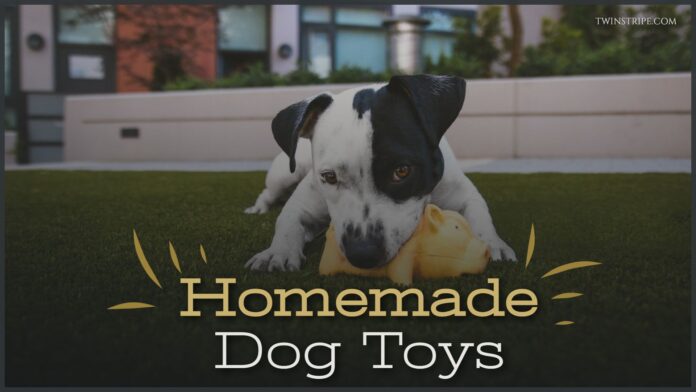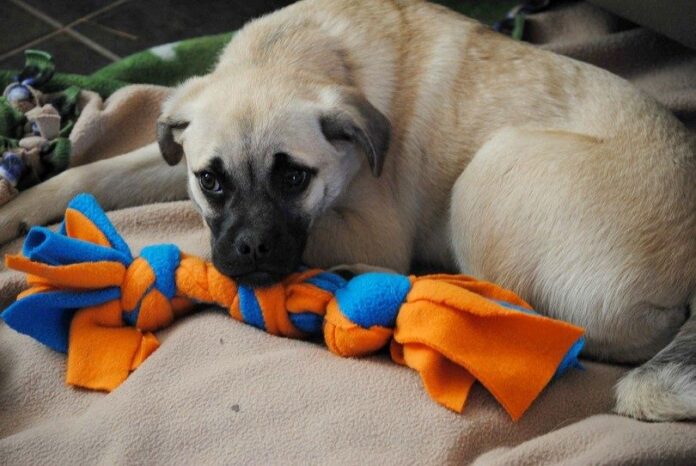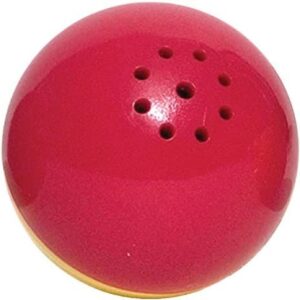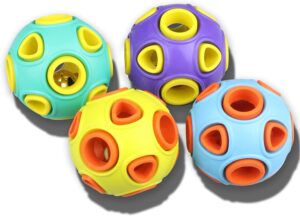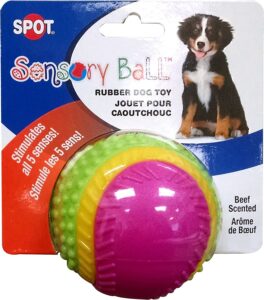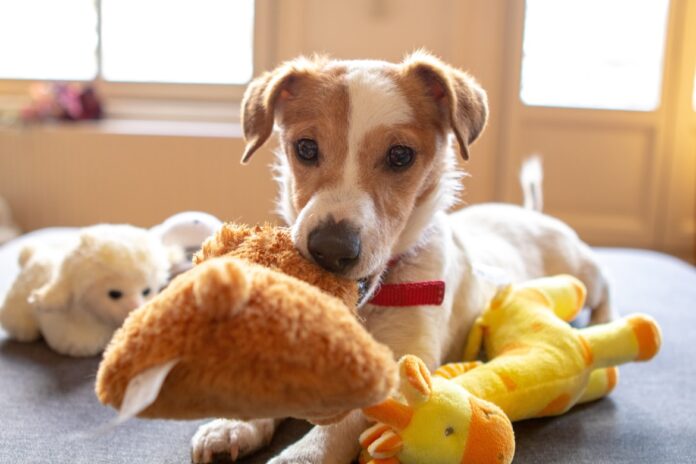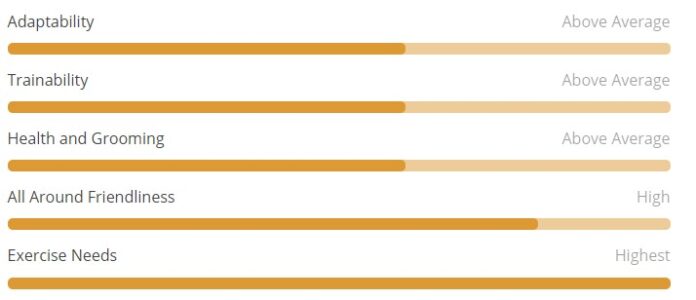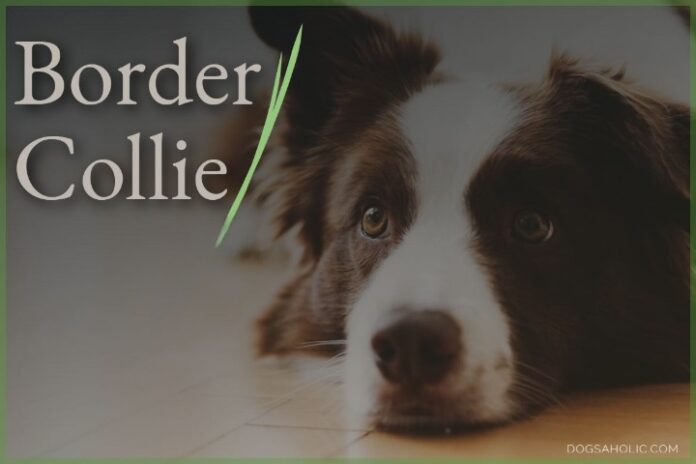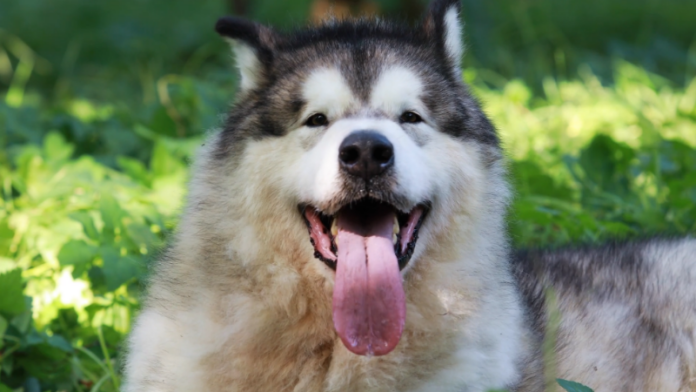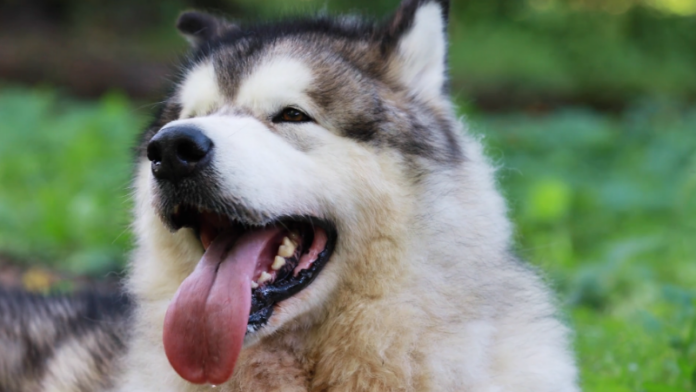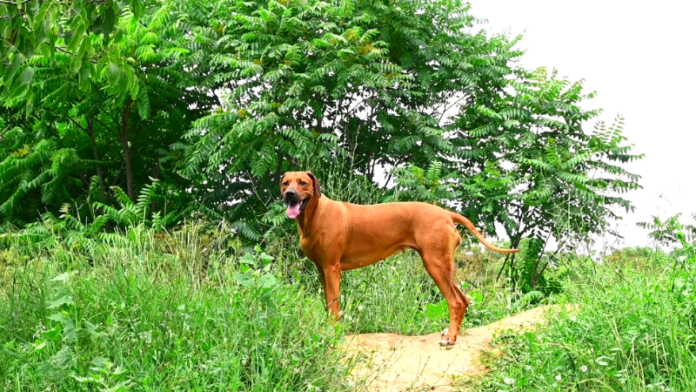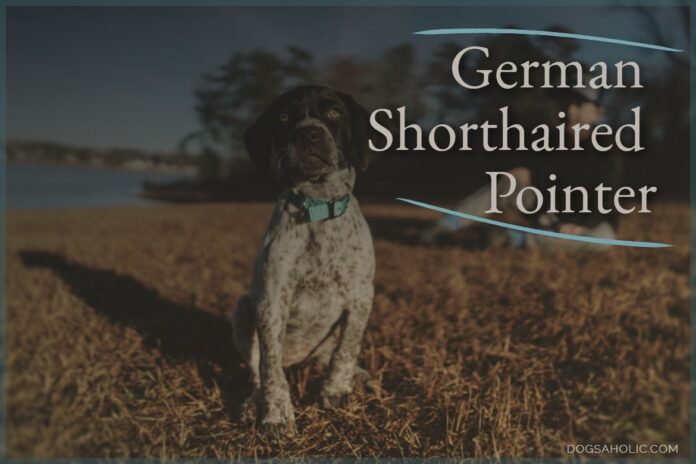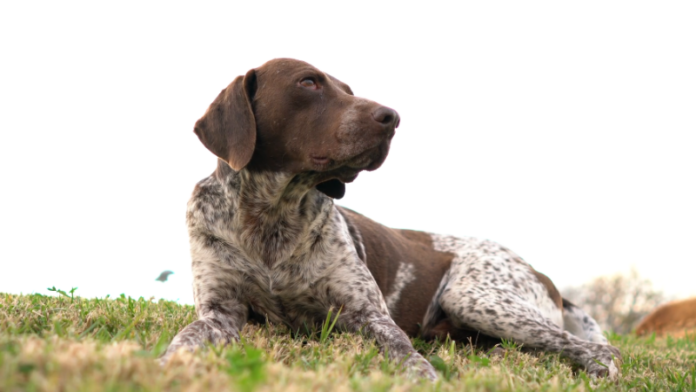The more you get to know dogs, the more you will realize how much they have in common with their masters.
They get depressed when you aren’t around, they get nervous when they don’t understand what is going on, and when they get bored they have a tendency to get themselves into a whole heap of trouble.
No amount of training or correction system will handle or even cure situations like these better than interactive dog toys.
They give Rover the opportunity to remain his own peppy self when left in his crate for several hours, exercise his mind as well as his body, and as is the case with some products, relate to you on a new level.
In this article we will explore the many options available on the market. We will also guide you to making the right purchase for your furry companion. Every pet is stimulated differently, and it is up to you as the individual owner to determine which toy is best.
You will find that there are a number of items to consider, like the chew factor and eating habits, while making your selection, but by taking this information into account, you will be able to pull your wallet out with confidence. Rover might pay a little less attention to you, but he will love you more for buying him such an engaging toy.
Chew Toys
Chew toys are a favorite of both dogs and owners. They are some of the most widely known and readily available. You can find them at the local pet store, supermarket, dollar store, or even online and they are generally inexpensive They are easily tossed for fetching, hidden for hunting games, and even stretched out for classic tug-of-war matches.
Cleaning is usually a snap, too. As they come in two types, it is best that you chose one that is best for your dog as it pertains to how you him to play with it.
Also, you need to gauge his chewing habits before selecting one. Gentle chewers should have plush toys. Those with an average style can adapt to just about any toy available. Those who like to power through everything with their teeth are best suited for hard rubber.

The sensory type of interactive toy for dogs is perhaps the most common on the market. These are the kind that get Rover into the mood of play with squeaks and crunches, and have a variety of tactile surfaces such as fur or rubber tips.
Some may allow him to sink his teeth into them, while others might crinkle every time he swipes at it with his paw. Regardless of the sense that the toy stimulates, the point of these toys is to cure boredom by keeping him interested in the product itself.
As many experienced owners will tell you, it doesn’t take much to capture the attention of a dog, and sometimes the simplest things work the best. Though it is a good rule to invest in several of them, for two reasons.
The first is because having two to four of them will allow Rover to choose which one he wants to play with at any given time, while the second is simply to have some backups. They can get lost, left outside, or they just might need to be replaced.

Many owners find that the indestructible toys become their personal favorites because, unless the dog is extremely rough with its playthings, these are one-time buys. They never have to worry about replacing it because no matter how much Rover worries at the toy’s edges, his teeth will not shred or even fray the edges. These products are made of hard, rubberized materials or dense plastics that hold up to their classification name.
They work better than bones and dental treats to help keep teeth clean, mostly because they don’t deteriorate, get soggy, or need to be replaced.
Also, depending on the shape and size of the toy, they can be used in owner/companion play just like the sensory type mentioned above. They are a little more expensive, but as smart shoppers will tell you, they are well worth the price.
One thing to keep in mind with any indestructible toy is that they can suffer cuts and gouges from the worst chewers. You should replace any toy that is falling apart. Supervise your pooch to see how he handles this toy. If he is small, yet tears his up, you should try the larger size, if available.
Treat Toys
These types of toys are designed to keep Rover busy by giving him little snacks while he continues to play. Rawhide and dental bones are good examples, though they are centered more on taste than actual food.
Other kinds include those that you fill with kibble or treats and they spill out as Rover plays with it. Some even allow you to fill it with peanut butter or other foods. These can keep him occupied for hours as he attempts to lick out every tiny morsel.

Durability is always something to keep in mind as you shop for the right one. If your pup is a chewer, odds are that the inexpensive ones will not last as long as the company suggests it will. It’s also a factor to consider when it comes to cleaning up after him. Little chunks of plastic or rubber from a destroyed toy can do the same to your vacuum cleaner!
Puzzle Toys
Another type of toy is the puzzle. Yes, dogs can and love to solve puzzles, especially if there is some kind of reward at the end. These are geared toward testing memory and developing the ability to recall.
They also alleviate boredom. Puzzle toys are designed so that Rover must employ a series of actions to get a treat, such as pressing, pulling, nibbling, or other action on certain parts of the toy. This gives him both a mental and a physical workout that will stave off hours of boredom (not to mention that it will be entertaining for you to watch him solve it over and again).

There are two drawbacks to these types. If your pooch has a tendency to be destructive, he could pull it to pieces in no time, so before buying one, make sure to investigate the various moving or loose parts that he may tear apart.
The other thing to consider is the fact that he may not be interested in puzzles. If possible, let him experiment with a display model or borrow one from a friend. It shouldn’t take more than a few minutes to learn if this the toy for him.
Interactive Dog Toys Product Recommendations
There are literally thousands of interactive toys to choose from. The following is a list of those that come highly recommended by owners, trainers, and veterinarians. They have been quality tested and most have been on the market in some version for years. When choosing a product, make sure that it complements your dog’s needs for active engagement and his interest level.
Dogs can be just like children when it comes to the things they play with. They tend to key in on certain types of toys and ignore others, no matter how expensive or stimulating you thought it to be. You may even discover that Rover enjoys playing with the box more than the toy itself.
1. Kong Extreme by Kong
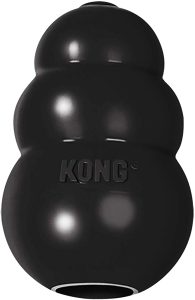
This indestructible toy was designed with the most intense chewers in mind. It is made of a special black rubber compound that gives it extra durability, and its pear-like shape enables it to bounce in unpredictable ways.
Your dog will spin in circles trying to figure out just which way it will go when you toss it and bring it back begging for another go. He will never grow bored because, to him, each round is a whole new game. It has a hollow core that you can stuff with treats.
Owners who fill it with kibble or other loose food and then either freeze it or pack it with peanut butter claim that their companions will spend hours gnawing at the KONG. It comes in three sizes, so it is suitable for any breed.
The indestructible material and the hollow, pear-shaped design help with behavioral issues. You can alleviate separation anxiety by filling it with treats and then giving it to Rover in his crate just before you leave. He will be so focused on getting at the food that by the time he’s eaten it all he’s gotten used to the fact that he is home alone.
Having the KONG in the crate or other place in the home when he is bored gives him something to expend his energy on other than damaging the furniture and barking up a storm at every passing car. Each time he loses his grip on it, it will bounce away, and it becomes a whole new game yet again.
2. Bob-a-lot by Starmark

This treat-dispensing toy resembles a pear or gourd. Its bulbous-belly sports tiny doors that dispense food as Rover plays with it. You are able to adjust the width of the opening for the size of your dog and the treats, and this also allows you to set a difficultly level for Rover to access the goods.
The weighted bottom allows the product to wobble and spin whenever he touches it with his paw. This helps to keep him entertained and prolong his snacking enjoyment. The screw-on cap enables you to easily fit up to three cups of treats, or alternatively, you could fill it with food and give it to him at mealtime.
This is an especially good idea for dogs who speed eat. It will take most dogs approximately 15 to 20 minutes to empty the contents, which is helpful to those dogs who are prone to bloat.
Another good point about the Bob-A-Lot is that, as long as there is something inside that Rover wants to get to, he will be entertained and exercised. He might even continue to play with it long after it is empty.
The one drawback with this toy is that it is not for chewers. The narrow neck and top are made of hard plastic, though they are vulnerable to those dogs who love to gnaw at anything they can fit into their mouths. Before purchasing this toy, observe how Rover treats his others. If he is typically easy on soft objects, then give the Bob-A-Lot a try, but if he can worry a bone away to slivers in a couple of hours, this is most likely not the one for him.
3. Flip Board, Level 2 by Trixie Pet Products
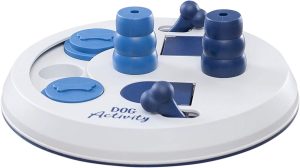
This puzzle is for dogs of varying skill and intelligence levels. It consists of lids that flip open, covers that slide over, and cones that lift straight up to reveal recesses in which you place treats for Rover to find.
By alternating the amount and placement of the treats, you can give him a new game each time you set the toy in front of him. The non-slip base keeps him from pushing it all over the floor, and the cones are designed in such a way that they cannot be knocked over to access the goods.
Instead, he must lift them straight up from the surface of the toy with his teeth. With three ways to get to the food, Rover will spend plenty of time trying to figure out how each one should be opened. This can help particularly fast eaters to slow down, and it will engage even the laziest of mutts in stimulating activity.
The Flip Board comes with an instructional booklet that will give you tips on how to increase the difficulty level and otherwise get the most out of the toy. It is dishwasher safe, so you should feel confident about keeping it clean even if you use wet or semi-moist food or treats in the compartments.
The only concern you might have about this toy is the cones. Since they designed to be removed by a dog’s mouth, they can become lost or chewed-up beyond use. Damage shouldn’t be too much of a concern because it does come with a one-year warranty on the moving parts.
4. Hide a Bee by Outward Hound

This four-piece bee-and-hive set is a cross between a dog puzzle and a sensory chew toy. It consists of a plush hive and three bees that squeak when squeezed or bitten. The object of the toy is for you to stuff the hive with the bees and then give it to your pup to figure out how to pull the bees from the holes in the side of the hive.
The high contrast of yellow and black will seize Rover’s attention, and the squeaks that come when he pulls one out of the hive will reinforce his sense of accomplishment just as his ancestors felt when hunting game.
Dogs of all intelligence levels should be able to master this type of puzzle in no time, but the interaction component is sure to keep them interested for as long as you are willing to keep stuffing the bees back into the hive. It may turn into a competition to see who tires first.
The most important thing to keep in mind when considering this sort of toy is the chew factor. The plush texture is a favorite among many dogs, but some can get a little carried away with their enthusiasm and end up yanking out all the stuffing in order to discover what is making the squeaking sounds from within.
If Fido is a heavy chewer, you should avoid this and most other plush toys. The good thing is that the Hide-A-Bee is relatively inexpensive as compared to other products in its class, so if he does manage to tear it apart, it shouldn’t make a huge impact on your wallet.
Conclusion
There are thousands of interactive toys on the market. Making a choice may seem overwhelming, but if you know your dog, you should be able to narrow down your selection in a matter of moments.
Take some time to consider Rover’s personality and habits and then compare them with three general categories. If he is a chewer, go for something hard and bouncy; if he gobbles his dinner in less than 60 seconds, pick a treat dispenser to slow him down; if he’s not very active, try a puzzle to stimulate his mind.
Do some research while shopping to see how other dogs reacted to the products. But regardless of your eventual choice, you will have provided Rover with hours of entertainment and given him a more impactful psychological boost than a plain old bone ever could.


